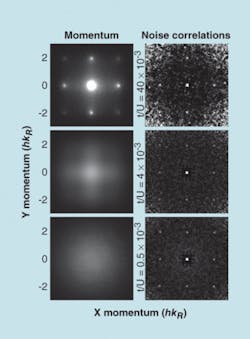QUANTUM COMPUTING: Atomic noise may help design quantum computers

Superfluid Bose-Einstein systems condensed into insulating optical lattices are becoming popular vehicles for exploring quantum phases and quantum phase transitions that originated as theoretical Hamiltonian expressions for condensed-matter physics problems, such as the Mott insulating phase and the superfluid phase of a Bose-Hubbard model. Researchers at the Joint Quantum Institute of the National Institute of Standards and Technology (NIST) and the University of Maryland (Gaithersburg, MD) have used this technique in an experiment to partition about 170,000 cold atoms from a superfluid Bose-Einstein condensate into the optical lattice of energy wells in a 2-D Mott insulator, which, unlike its 1-D and 3-D Mott insulator cousins, has gone largely unexplored to date, according to the NIST researchers.1 By loading just one atom into each well, scientists hope to create the initial state of a hypothetical quantum computer using neutral atoms to store and process information.
Building on earlier work by other groups, the Maryland-based researchers have found that images of “noise” in clouds of ultracold atoms trapped by lasers reveal structural patterns previously obscured by quantum effects, including the spaces between atoms and cloud size. They formed the square optical lattice in the x-y plane using a pair of linearly polarized 820 nm laser beams. The interparticle-interaction energy in the lattice is represented by U, the quantum tunneling or hopping is represented by t, and the system Hamiltonian is characterized by a single dimensionless coupling parameter t/U. Results at three values of t/U—40 × 10-3, 4 × 10-3, and 0.5 × 10-3—are shown from top to bottom (see figure).
The researchers reported that they observed “a remarkable agreement between experiment and theory describing the momentum distribution of a 2‑D Mott insulator over a wide range of conditions,” which, they wrote, “adds support to proposals to identify the phases of extended Bose-Hubbard models (including a possible supersolid phase), using a combination of momentum and noise-correlation measurements.” Lead author Ian Spielman likened the technique to listening to a noisy ballroom: “While it may be impossible to hear specific conversations, correlations in noise can show where people (or atoms) are located in relation to each other, and the volume of noise can indicate the size of the ballroom (or atomic cloud).”
REFERENCE
1. I.B. Spielman et al., Physical Rev. Lett. 98, 080404 (Feb. 23, 2007).
CORRECTION
A headline in the March issue incorrectly charactized an achievement in silicon photonics at Intel. The headline should have read: “Silicon-waveguide modulator reaches 30 Gbit/s” (March 2007, p. 28; www.laserfocusworld.com/articles/286504). Laser Focus World regrets the error.
About the Author
Hassaun A. Jones-Bey
Senior Editor and Freelance Writer
Hassaun A. Jones-Bey was a senior editor and then freelance writer for Laser Focus World.